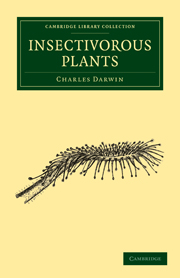Book contents
- Frontmatter
- Contents
- CHAPTER I DROSERA ROTUNDIFOLIA, OR THE COMMON SUN-DEW
- CHAPTER II THE MOVEMENTS OF THE TENTACLES FROM THE CONTACT OF SOLID BODIES
- CHAPTER III AGGREGATION OF THE PROTOPLASM WITHIN THE CELLS OF THE TENTACLES
- CHAPTER IV THE EFFECTS OF HEAT ON THE LEAVES
- CHAPTER V THE EFFECTS OF NON-NITROGENOUS AND NITROGENOUS ORGANIC FLUIDS ON THE LEAVES
- CHAPTER VI THE DIGESTIVE POWER OF THE SECRETION OF DEOSERA
- CHAPTER VII THE EFFECTS OF SALTS OF AMMONIA
- CHAPTER VIII THE EFFECTS OF VARIOUS OTHER SALTS, AND ACIDS, ON THE LEAVES
- CHAPTER IX THE EFFECTS OF CERTAIN ALKALOID POISONS, OTHER SUBSTANCES AND VAPOURS
- CHAPTER X ON THE SENSITIVENESS OF THE LEAVES, AND ON THE LINES OF TRANSMISSION OF THE MOTOR IMPULSE
- CHAPTER XI RECAPITULATION OF THE CHIEF OBSERVATIONS ON DROSERA ROTUNDIFOLIA
- CHAPTER XII ON THE STRUCTURE AND MOVEMENTS OF SOME OTHER SPECIES OF DROSERA
- CHAPTER XIII DIONÆA MUSCIPULA
- CHAPTER XIV ALDROVANDA VESICULOSA
- CHAPTER XV DROSOPHYLLUM — RORIDULA — BYBLIS — GLANDULAR HAIRS OF OTHER PLANTS — CONCLUDING REMARKS ON THE DROSERACEÆ
- CHAPTER XVI PINGUICULA
- CHAPTER XVII UTRICULARIA
- CHAPTER XVIII UTRICULARIA (continued)
- ERRATA
- INDEX
CHAPTER II - THE MOVEMENTS OF THE TENTACLES FROM THE CONTACT OF SOLID BODIES
Published online by Cambridge University Press: 29 August 2010
- Frontmatter
- Contents
- CHAPTER I DROSERA ROTUNDIFOLIA, OR THE COMMON SUN-DEW
- CHAPTER II THE MOVEMENTS OF THE TENTACLES FROM THE CONTACT OF SOLID BODIES
- CHAPTER III AGGREGATION OF THE PROTOPLASM WITHIN THE CELLS OF THE TENTACLES
- CHAPTER IV THE EFFECTS OF HEAT ON THE LEAVES
- CHAPTER V THE EFFECTS OF NON-NITROGENOUS AND NITROGENOUS ORGANIC FLUIDS ON THE LEAVES
- CHAPTER VI THE DIGESTIVE POWER OF THE SECRETION OF DEOSERA
- CHAPTER VII THE EFFECTS OF SALTS OF AMMONIA
- CHAPTER VIII THE EFFECTS OF VARIOUS OTHER SALTS, AND ACIDS, ON THE LEAVES
- CHAPTER IX THE EFFECTS OF CERTAIN ALKALOID POISONS, OTHER SUBSTANCES AND VAPOURS
- CHAPTER X ON THE SENSITIVENESS OF THE LEAVES, AND ON THE LINES OF TRANSMISSION OF THE MOTOR IMPULSE
- CHAPTER XI RECAPITULATION OF THE CHIEF OBSERVATIONS ON DROSERA ROTUNDIFOLIA
- CHAPTER XII ON THE STRUCTURE AND MOVEMENTS OF SOME OTHER SPECIES OF DROSERA
- CHAPTER XIII DIONÆA MUSCIPULA
- CHAPTER XIV ALDROVANDA VESICULOSA
- CHAPTER XV DROSOPHYLLUM — RORIDULA — BYBLIS — GLANDULAR HAIRS OF OTHER PLANTS — CONCLUDING REMARKS ON THE DROSERACEÆ
- CHAPTER XVI PINGUICULA
- CHAPTER XVII UTRICULARIA
- CHAPTER XVIII UTRICULARIA (continued)
- ERRATA
- INDEX
Summary
I will give in this arid the following chapters some of the many experiments made, which best illustrate the manner and rate of movement of the tentacles, when excited in various ways. The glands alone in all ordinary cases are susceptible to excitement. When excited they do not themselves move or change form, but transmit a motor impulse to the bending part of their own and adjoining tentacles, and are thus carried towards the centre of the leaf. Strictly speaking, the glands ought to be called irritable, as the term sensitive generally implies consciousness; but no one supposes that the Sensitive-plant is conscious, and as I have found the term convenient, I shall use it without scruple. I will commence with the movements of the exterior tentacles, when indirectly excited by stimulants applied to the glands of the short tentacles on the disc. The exterior tentacles may be said in this case to be indirectly excited, because their own glands are not directly acted on. The stimulus proceeding from the glands of the disc acts on the bending part of the exterior tentacles, near their bases, and does not (as will hereafter be proved) first travel up the pedicels to the glands, to be then reflected back to the bending place. Nevertheless, some influence does travel up to the glands, causing them to secrete more copiously, and the secretion to become acid.
- Type
- Chapter
- Information
- Insectivorous Plants , pp. 19 - 37Publisher: Cambridge University PressPrint publication year: 2009First published in: 1875



